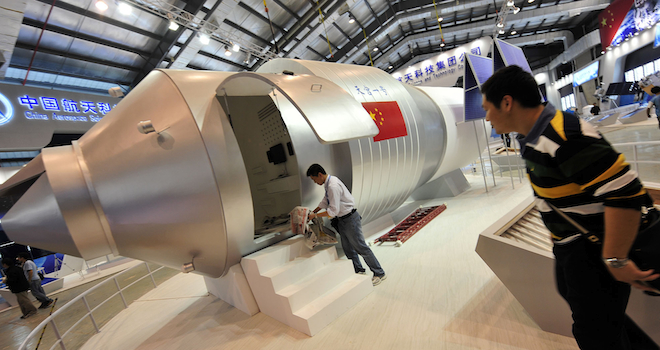International space exploration efforts have been having a rough couple of weeks.
Just as NASA and the Russian Space Agency are considering temporarily abandoning the International Space Station in November following the crash of an unmanned Russian Soyuz cargo supply vehicle last week, Thursday brought the news that China too is delaying the launch of the prototype module of its own planned space station in the wake of the crash of a separate Chinese rocket that occurred in mid-August.
The Tiangong-1 (“Heavenly Palace-1” in English) is an 8.5-ton unmanned space module developed by the China National Space Administration (CNSA) for the purpose of testing docking procedures in orbit that will be used to connect subsequent, manned modules to form China’s first planned space station by 2020.
The much-hyped (by the Chinese government) craft was initially due to be launched at the end of August or early September, but will now be delayed indefinitely, at least until the cause of the crash is pinpointed.
But on Aug. 19, a Chinese rocket known as the Long-March II-C that was carrying the SJ-11-04, an experimental orbiter not related to the space station, malfunctioned upon takeoff and failed to enter orbit.
The Chinese government initially said that the crash wouldn’t delay the Tiangong-1 launch because the Tiangong-1 was due to blast-off on a separate class of rocket, the Long-March II F, which is “China’s most well-known and reliable rocket,” according to state news outlet Xinhua.
Yet today, the Chinese government has apparently done a double-take and decided the two transport rockets are in-fact, close enough in terms of technical specifications to warrant delaying the launch of the Tiangong-1.
English-language paper China Daily quotes an unnamed spokesman from the China National Space Administration, who said “As the investigation into the malfunction of the rocket Long-March II-C remains underway, it is not clear yet whether the malfunction is linked with the Long-March II-F…The specific launch date for the Tiangong-1 will be set based on the results of the investigation into the malfunctioning rocket.”
Still, there can be no denying that China will attempt to get the craft up as soon as possible and probably before or on the China National Day holiday on October 1, celebrating the 62nd anniversary of the communist regime.
China’s grandiose space ambitions have caused some controversy in recent years, with the prospective date range of China’s first continuously human-crewed space station, 2020-2022, coinciding with the planned decommissioning of the International Space Station.
The U.S. Department of Defense released a report this year warning of the country’s attempt to weaponize space. Other scientists have raised skepticism that Chinese space technology is as advanced as the country’s government claims.









